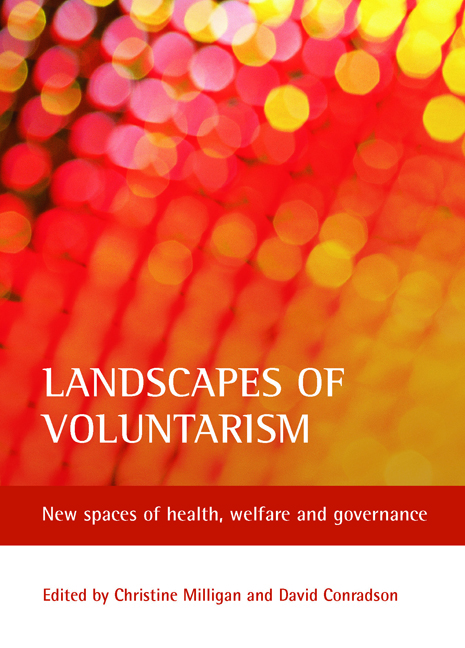Book contents
- Frontmatter
- Contents
- List of tables, figures, maps and plates
- Notes on contributors
- Foreword: Beyond the shadow state?
- one Contemporary landscapes of welfare: the ‘voluntary turn’?
- two A ‘new institutional fix’? The ‘community turn’ and the changing role of the voluntary sector
- three Renewal or relocation? Social welfare, voluntarism and the city
- four Voluntarism and new forms of governance in rural communities
- five New times, new relationships: mental health, primary care and public health in New Zealand
- six Informal and voluntary care in Canada: caught in the Act?
- seven Competition, adaptation and resistance: (re)forming health organisations in New Zealand’s third sector
- eight The difference of voluntarism: the place of voluntary sector care homes for older Jewish people in the United Kingdom
- nine Values, practices and strategic divestment: Christian social service organisations in New Zealand
- ten Faith-based organisations and welfare provision in Northern Ireland and North America: whose agenda?
- eleven Government restructuring and settlement agencies in Vancouver: bringing advocacy back in
- twelve Developing voluntary community spaces and Ethnicity in Sydney, Australia
- thirteen The voluntary spaces of charity shops: workplaces or domestic spaces?
- fourteen The changing landscape of voluntary sector counselling in Scotland
- fifteen Volunteering, geography and welfare: a multilevel investigation of geographical variations in voluntary action
- sixteen Reflections on landscapes of voluntarism
- Index
twelve - Developing voluntary community spaces and Ethnicity in Sydney, Australia
Published online by Cambridge University Press: 15 January 2022
- Frontmatter
- Contents
- List of tables, figures, maps and plates
- Notes on contributors
- Foreword: Beyond the shadow state?
- one Contemporary landscapes of welfare: the ‘voluntary turn’?
- two A ‘new institutional fix’? The ‘community turn’ and the changing role of the voluntary sector
- three Renewal or relocation? Social welfare, voluntarism and the city
- four Voluntarism and new forms of governance in rural communities
- five New times, new relationships: mental health, primary care and public health in New Zealand
- six Informal and voluntary care in Canada: caught in the Act?
- seven Competition, adaptation and resistance: (re)forming health organisations in New Zealand’s third sector
- eight The difference of voluntarism: the place of voluntary sector care homes for older Jewish people in the United Kingdom
- nine Values, practices and strategic divestment: Christian social service organisations in New Zealand
- ten Faith-based organisations and welfare provision in Northern Ireland and North America: whose agenda?
- eleven Government restructuring and settlement agencies in Vancouver: bringing advocacy back in
- twelve Developing voluntary community spaces and Ethnicity in Sydney, Australia
- thirteen The voluntary spaces of charity shops: workplaces or domestic spaces?
- fourteen The changing landscape of voluntary sector counselling in Scotland
- fifteen Volunteering, geography and welfare: a multilevel investigation of geographical variations in voluntary action
- sixteen Reflections on landscapes of voluntarism
- Index
Summary
Introduction
Public places and facilities are highly significant features of any urban landscape, yet in the country of arrival, many immigrants find such places to be unfamiliar and unwelcoming. They may be experienced as inadequate, inappropriate, inaccessible or even unfriendly to their needs (Lewis, 1978; Kraus, 1994). The development of community facilities through collective action by immigrant populations is thus often initiated as a way of reproducing the familiar plazas, streets, places of worship and leisure that defined everyday habitus in a place of origin. In this way, immigrant communities come to play an important role in the development of a nation's social infrastructure. They contribute to changes in the urban landscape through the development of diverse communal places designed to satisfy their collective needs.
As a way of exploring these issues, this chapter explores the development of voluntary and non-commercial communal spaces by non-English speaking immigrants in Sydney, Australia. Since the early 1950s, Sydney has been a city in which diverse ethnic communities have sought to establish their own places of worship, education, welfare and leisure and recreation. These developments have changed the urban landscape of a society that had previously been largely defined by cultural traditions imported from Britain (Connell, 2000; Burnley, 2001). The concern, here, is to consider how such developments play a crucial role in helping immigrants to settle in to their new social environment. While the chapter draws on a specific case study, it is argued that parallels can be found in many other places of migrant destination.
The chapter begins by examining the notion of ‘communal home’ as a key outcome of voluntary collective immigrant endeavour. Communal places or homes are considered, unlike public goods, to have a particular significance for specific segments of the community, in this case an ethnic collective. Many ethnic communities feel the need to establish such places, in part to address the cultural challenges encountered during settlement in the new environment. The resulting sites are thus of both symbolic and material significance. To ground this argument in the Australian context, the chapter outlines the key elements of postwar demographic and cultural change in Sydney.
- Type
- Chapter
- Information
- Landscapes of VoluntarismNew Spaces of Health, Welfare and Governance, pp. 209 - 230Publisher: Bristol University PressPrint publication year: 2006



